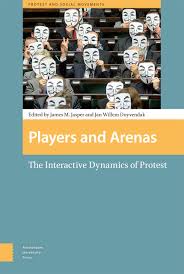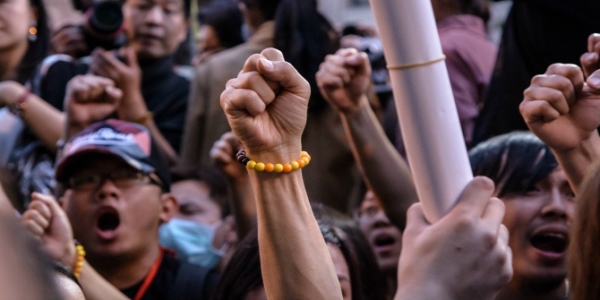Book Review: Players and Arenas: The Interactive Dynamics of Protest edited by James M. Jasper and Jan Willem Duyvendak
Players and Arenas: The Interactive Dynamics of Protest, edited by James M. Jasper and Jan Willem Duyvendak, employs a strategic interaction perspective to the study of social movements, bringing to the fore the relational dynamics between various players across different social arenas. In the face of mounting criticism of the movement-centric nature of the scholarship in this field, this effort is an invaluable contribution, writes Asma Ali Farah.
Players and Arenas: The Interactive Dynamics of Protest. James M. Jasper and Jan Willem Duyvendak (eds). Amsterdam University Press. 2015.
 This edited volume, Players and Arenas: The Interactive Dynamics of Protest, endeavours to move away from the structural and movement-centric bias in the study of social movements, using a strategic interaction perspective that brings to the fore the relational dynamics between various players across different social arenas. The key assumption is that the occurrence, development and outcomes of protest are the result of the actions, reactions and interactions of different players. This idea has its roots in previous works by the sociologist James M. Jasper (2004; 2006; and 2011), which highlight the significance of strategy for social movements.
This edited volume, Players and Arenas: The Interactive Dynamics of Protest, endeavours to move away from the structural and movement-centric bias in the study of social movements, using a strategic interaction perspective that brings to the fore the relational dynamics between various players across different social arenas. The key assumption is that the occurrence, development and outcomes of protest are the result of the actions, reactions and interactions of different players. This idea has its roots in previous works by the sociologist James M. Jasper (2004; 2006; and 2011), which highlight the significance of strategy for social movements.
In the book’s players-and-arenas framework, players denote ‘those who engage in strategic action with some goal in mind’, and can be either individuals – ‘simple players’ – or groups of individuals – ‘compound players’ (10). An arena is ‘a bundle of rules and resources that allow or encourage certain kinds of interactions to proceed, with something at stake’ (14), and can refer to either a physical or symbolic site of strategic interactions (306). Not only do players and arenas vary in their characteristics, but players can be arenas and arenas can be players: compound players such as organisations are also sites of conflicts and cooperation (12), while aggregate arenas like the media actively intervene in and shape political battles (109).
While I appreciate that this volume covers a variety of players, arenas and strategic interactions, it could be organised differently to be more coherent. The book is divided into three unequal parts, with each section tackling various themes. Perhaps it would have been a better idea to organise the sections according to the type of players, arenas or relationships involved. Despite this shortcoming, this volume addresses two issues that are not given due consideration in social movement studies, and which I discuss below: firstly, the influence of external actors on social movements and protesters and, secondly, why these external actors choose to become allies of social movements or protesters.
In Chapter One, Francesca Polletta and Kelsy Kretschmer discuss the roles played by external and internal players in social movement factionalism. Taking the US Civil Rights movement as an illustrative case, they show how the government, law enforcement agencies, the media, allies, other movements and incipient factional groups can affect the development and trajectory of factional clashes (39-42). However, these actors do not determine the outcomes of these battles, for the strategic choices made by social movements influence whether or not they are able to diffuse, divert or overcome them (44-45). Thus, factional battles do not inevitably lead to schism. Moreover, even if schism were to happen, it would not necessarily signify the end of the relationship between different movement factions, for ‘the pressures of reform politics may pull them back toward each other’ (47).
In Chapter Two, Ann Mische agrees that there is nothing deterministic about the internal splintering of social movement arenas. Ann shows that the breakdown of the 1997 Annual Congress of Brazil’s National Student Union was unexpected until the very last moment, and owed very much to the strategic choices used in response to rising tensions and divisions within the student movement. Indeed, stylistic tendencies and communicative processes constrained the ability of leaders to mediate between the various factions (74). Nevertheless, this breakdown did not destroy the student movement in Brazil, demonstrating once again that schism is not necessarily fatal (77).
In Chapter Eight, Walter Nicolls and Justus Uitermark go into more detail about the ways in which movement players simultaneously support and thwart social movement efforts. In the immigrant and LGBT+ movements in the United States, intellectuals have sought to use their expertise to support marginalised groups. However, in their struggle to gain recognition for these groups from the public and achieve policy change, they have engaged in discourses that privileged certain norms and individuals over others within these groups (206-07). Thus, ‘if intellectuals use their skills for the movement, they marginalise others within the movement who lack such skills’, engendering a ‘Power of Representation dilemma’ (206).
An issue that is also overlooked in social movement studies is the decision of external players to interact with social movements. Why do they choose to support them? In Chapter Three, Edward T. Walker uses regression analysis to explain why corporate foundations in the health sector donate to disease advocacy groups in the United States. Walker finds that while the density of health advocacy groups may account for this, the pressure actually comes from ‘community effects’ and ‘industry effects’, which refer respectively to the amount of giving by other health-related foundations in the same geographical area, and giving by other foundations in the same health industry (88-89). Moreover, Walker finds that a significant proportion of donations in the health sector comes from device and pharmaceutical companies, suggesting that donations are used to further marketing interests (93).
Meanwhile, in Chapter Eleven, Silke Heumann and Duyvendak explore the involvement of religious groups in the pro-life movement in Nicaragua after the 1990 elections. Through their document analysis and interviews with Catholic and Evangelical activists and advocates, they find that churches and religious networks had to be approached and actively recruited by pro-lifers to promote social conservatism. Thus, religious bodies are not intrinsically political, but need to be converted into platforms for political mobilisation (253, 270).
In conclusion, this edited collection is an invaluable contribution to social movements studies as it addresses issues that are not given due attention in the social movement literature, such as what drives some political actors to become allies of social movements. More generally, Players and Arenas offers close analysis of the ways in which strategic interactions between various political players affect social movements. In the face of mounting criticism of the movement-centric nature of the scholarship, this effort is particularly welcome.
—
Note: This review gives the views of the author, and not the position of the Democratic Audit blog, or of the London School of Economics. It originally appeared on the LSE Review of Books. Please read our comments policy before posting.
—
Asma Ali Farah is a PhD candidate at the Department of Politics and International Relations, at Royal Holloway, University of London. She holds an MSc in International Relations from Royal Holloway. Her research interests include political participation, political representation, government responsiveness to protest, and women’s rights. Read more by Asma Ali Farah.






 Democratic Audit's core funding is provided by the Joseph Rowntree Charitable Trust. Additional funding is provided by the London School of Economics.
Democratic Audit's core funding is provided by the Joseph Rowntree Charitable Trust. Additional funding is provided by the London School of Economics.
#BookReview: Players & Arenas: The Interactive Dynamics of #Protest ed by James M. Jasper & Jan Willem Duyvendak https://t.co/q7n950Mzml
Book Review: Players and Arenas: The Interactive Dynamics of Protest ed. James M. Jasper and Jan Willem Duyvendak https://t.co/TOYvHItYNq
Book Review: Players and Arenas: The Interactive Dynamics of Protest edited James M. Jasper and Jan Willem Duyvendak https://t.co/TOYvHItYNq
Book Review: Players and Arenas: The Interactive Dynamics of Protest edited by James M.… https://t.co/588qp5GZV0 https://t.co/y1byqrHPsi